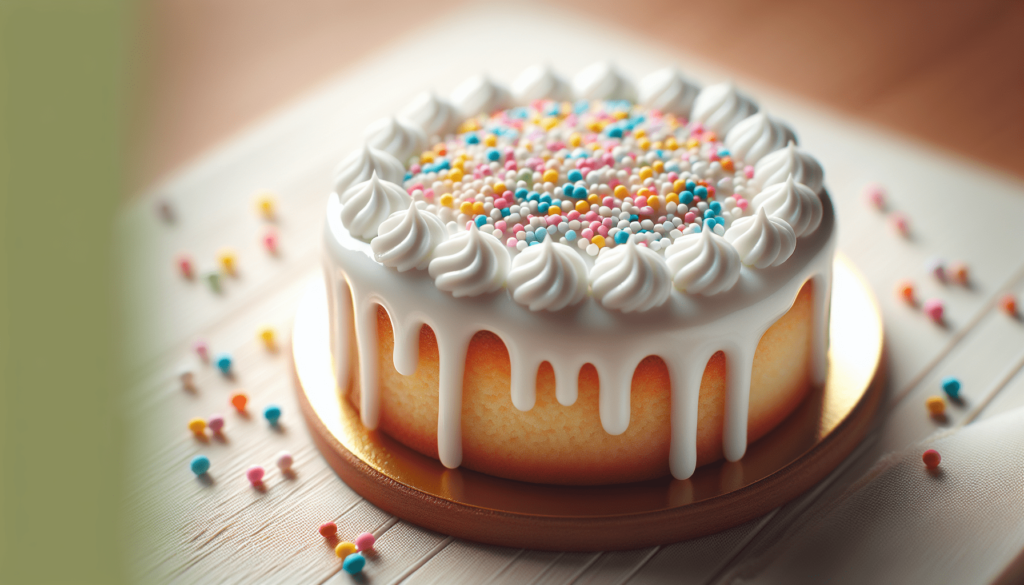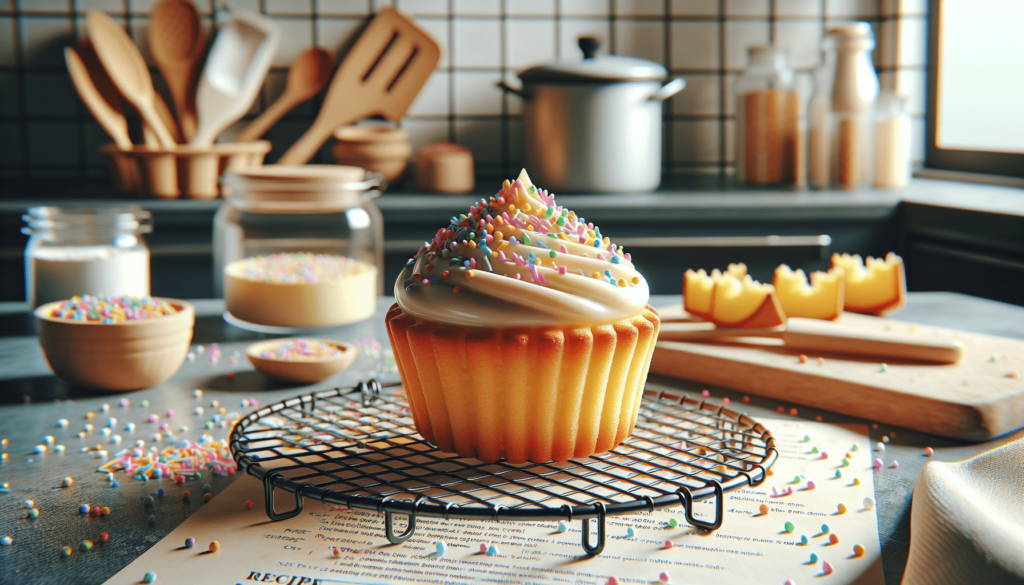Are you craving something sweet and delicious? Look no further than the Sweet Cakes Recipe! This delectable treat will satisfy your sweet tooth and leave you wanting more. With its moist and fluffy texture, combined with the perfect amount of sweetness, these cakes are a dessert lover’s dream come true. Whether you’re baking for a special occasion or simply indulging in a sweet treat for yourself, this recipe is a must-try. Get ready to impress your taste buds and all those lucky enough to enjoy these mouthwatering Sweet Cakes.

Cake Base
Choosing the Right Flour
When it comes to creating the perfect cake base, one of the key considerations is the type of flour you choose. All-purpose flour, with its moderate protein content, is a popular choice for most cake recipes. It strikes a balance between tenderness and structure, resulting in a moist and fluffy texture. However, if you’re looking for a lighter and more delicate cake, cake flour is your best option. This finely milled flour has a lower protein content, lending a soft and tender crumb to your cake.
Selecting the Perfect Sugar
Choosing the right sugar for your cake can impact its texture and flavor. Granulated white sugar is the go-to choice for most cake recipes. It provides sweetness and tends to dissolve easily, ensuring a smooth batter. If you prefer a deeper flavor, consider using brown sugar. With its molasses content, brown sugar adds a subtle caramel note to your cake. You can also experiment with alternative sugars like coconut sugar or maple syrup for unique flavor profiles.
Essential Leavening Agents
Leavening agents are crucial for achieving a light and airy cake. Baking powder and baking soda are the most common leavening agents used in cake recipes. Baking powder is a combination of an acid and a base, which produces carbon dioxide when combined with liquids and heat. This creates the rise in your cake. Baking soda, on the other hand, requires an acidic ingredient like buttermilk or lemon juice to activate its leavening properties. Understanding the balance between these agents is essential for achieving the desired texture in your cake.
Flavorful Additions
Exploring Taste Options
Now that you have your cake base, it’s time to infuse it with delightful flavors. The options are endless! Vanilla extract is a classic choice that complements almost any cake recipe. For a burst of citrus, you can add lemon or orange zest to your batter. If you’re feeling adventurous, why not try almond or peppermint extract? These flavorings can elevate your cake and add a unique twist.
Incorporating Fruit
Fresh fruits can bring a burst of natural sweetness and moisture to your cake. Berries like strawberries, raspberries, or blueberries can be folded into the batter for a burst of flavor and vibrant color. Bananas, apples, and even pineapple can also be used to create a deliciously moist cake with a hint of natural sweetness. Just be sure to adjust your recipe to accommodate the additional moisture from the fruits.
Adding Nuts and Spices
Nuts and spices are a fantastic way to enhance the flavor and texture of your cake. Nuts like almonds, walnuts, or pecans can provide a delightful crunch and nutty flavor. Toasting the nuts before incorporating them into your batter can intensify their taste. Spices like cinnamon, nutmeg, or cardamom can add warmth and depth to your cake, making it even more inviting. Experiment with different combinations to discover your personal favorite.
Moisture Boosters
Importance of Fats
Fats play a crucial role in creating a moist and tender cake. Butter, oil, or a combination of both are commonly used in cake recipes. Butter adds a rich flavor but can result in a denser texture, while oil contributes to a moist and lighter cake. Consider the flavor profile you desire when deciding which fat to use. The amount and type of fat in your recipe can greatly influence the final outcome of your cake.
Moisturizing with Dairy
Dairy products such as milk, buttermilk, yogurt, or sour cream can add moisture and richness to your cake. These ingredients not only improve the texture but also bring a tangy flavor to balance the sweetness. Buttermilk is a particularly excellent choice for achieving a tender crumb, while yogurt and sour cream can add a pleasant tanginess and moisture. Choose the dairy option that suits your taste preferences and complements your chosen flavors.
Including Liquid Sweeteners
Liquid sweeteners like honey or maple syrup can enhance the moisture content of your cake while adding a unique flavor profile. These natural sweeteners can provide depth and complexity to your dessert. When incorporating liquid sweeteners, it’s important to adjust the amount of other liquids in your recipe to maintain the desired consistency. Be mindful of the sweetness level as well, as liquid sweeteners can be more potent than granulated sugars.
Binding Agents
Using Eggs and Egg Replacements
Eggs are vital for binding the ingredients together and providing structure to your cake. They also contribute to moisture and help achieve a tender texture. If you have dietary restrictions or allergies, there are several egg replacements you can use. Applesauce, mashed bananas, or flaxseed mixed with water are popular substitutes in vegan baking. Each egg replacement may affect the texture and flavor of your cake differently, so experiment to find the best option for your needs.
Binding with Dairy Products
Dairy products such as milk, yogurt, or sour cream not only add moisture but also aid in binding the ingredients together. The proteins in dairy facilitate the formation of a tender and cohesive cake. If you’re looking for a richer and denser texture, consider using full-fat dairy products. However, if you prefer a lighter cake, low-fat or non-fat dairy options can still provide the necessary binding properties without the added richness.
Utilizing Baking Powder or Soda
Baking powder and baking soda, in addition to providing leavening properties, also act as binding agents in cake recipes. The carbon dioxide released during the baking process helps create air pockets, resulting in a lighter texture. Their interaction with other ingredients, such as acids, creates chemical reactions that aid in binding the batter together. It’s important to follow the recipe instructions carefully to maintain the right balance of leavening agents and binding agents for optimal results.

Texture Enhancements
Creaming Butter and Sugar
Creaming butter and sugar is a crucial step in cake baking. This process incorporates air into the mixture, resulting in a light and fluffy texture. It involves beating softened butter and sugar together until the mixture becomes pale and creamy. This technique helps create a good structure by evenly distributing the fat and sugar throughout the batter. The creamy texture achieved through creaming is the foundation for a well-risen and tender cake.
Emulsifying Liquids
Emulsification is the process of combining two immiscible liquids, such as oil and water, into a stable mixture. In cake baking, emulsifying the liquids ensures a uniform texture and prevents separation. This can be achieved by gradually adding the liquid ingredients to the dry ingredients while continuously mixing. The emulsification process plays a critical role in balancing the moisture and creating a smooth batter for your cake.
Incorporating Whipped Egg Whites
Whipped egg whites can provide an airy and light texture to your cake. Beating egg whites until they reach stiff peaks, and then folding them into the batter, creates a delicate and fluffy crumb. This technique is often used in chiffon or sponge cakes to achieve a light and ethereal texture. The whipped egg whites act as a natural leavening agent, giving your cake an extra lift and a tender structure.
Baking Techniques
Choosing the Right Pan
Choosing the right pan is essential for baking a successful cake. Different types of pans, such as round, square, or Bundt, can affect the baking time and the overall presentation of your cake. Ensure that your pan is of good quality and has a non-stick surface to prevent sticking. Understanding the capacity of your chosen pan and adjusting the recipe accordingly will help you achieve an evenly baked and perfectly shaped cake.
Lining and Greasing the Pan
Properly lining and greasing your cake pan are essential steps to ensure easy removal of your cake once it’s baked. Grease the pan using butter or cooking spray and then line the bottom with parchment paper. This prevents the cake from sticking to the pan, making it easier to release without any damage. Taking the time to properly prepare your pan will save you from any last-minute panicking and help you present a beautifully intact cake.
Temperature and Timing
Baking your cake at the correct temperature and for the appropriate duration is vital for achieving the desired texture and doneness. Follow the recipe instructions carefully, preheat your oven, and place the cake in the center of the oven for even heat distribution. Overbaking can result in a dry and crumbly cake, while underbaking can lead to a dense and gummy texture. Use a toothpick or cake tester to determine if your cake is fully cooked before removing it from the oven.
Frosting and Decorations
Classic Buttercream Frosting
Buttercream frosting is a classic choice for decorating cakes. Made with butter, powdered sugar, and flavorings, it offers a smooth and creamy texture. You can customize your buttercream by adding different extracts, such as vanilla, chocolate, or even fruit flavors. The consistency can be adjusted to your preference, ranging from a thin glaze for drizzling to a thick and spreadable frosting for intricate decorations. With buttercream, you can let your creativity shine and adorn your cake with beautiful designs.
Whipped Cream Frosting
For a lighter and less sweet option, whipped cream frosting is a delightful choice. Made by whipping heavy cream with sugar and vanilla extract, it provides a fluffy and airy topping for your cake. Whipped cream frosting pairs well with fruity flavors and adds a refreshing element to any dessert. Keep in mind that whipped cream is best enjoyed immediately or refrigerated, as it tends to lose its structure over time.
Creative Decoration Ideas
Decorating your cake allows you to showcase your creativity and make it truly special. You can use various techniques like piping, spreading, or stenciling to create eye-catching designs. Fresh fruits, edible flowers, or sprinkles can add a pop of color and texture to your cake. Chocolate ganache, caramel drizzle, or colorful fondant can also be used as decorative elements. Let your imagination guide you and have fun experimenting with different decorations to create a cake that’s visually stunning.
Storage and Serving
Proper Cake Storage
Knowing how to store your cake is essential to maintain its freshness and texture. If you’re not serving the cake immediately, it’s important to keep it in a cool and dry place. Depending on the frosting and filling, some cakes can be stored at room temperature, covered with a cake dome or plastic wrap. However, if your cake contains perishable ingredients like fresh cream or fruit, refrigeration is recommended to prevent spoilage. Always cover your cake properly to protect it from drying out or absorbing unwanted odors.
Tips for Freezing
Freezing cake can be a great way to extend its shelf life and have a sweet treat on hand whenever you want. To freeze your cake, ensure it’s completely cooled before wrapping it tightly in plastic wrap or an airtight container. You can freeze a whole cake or individual slices, depending on your preferences. When ready to enjoy, thaw the cake in the refrigerator overnight and bring it to room temperature before serving. Proper freezing and thawing techniques will help preserve the taste and texture of your cake.
Attractive Serving Presentation
The presentation of your cake can enhance the overall dining experience. Before serving, consider adding some finishing touches. Dusting your cake with powdered sugar, cocoa powder, or edible glitter can add visual appeal. Fresh fruit slices or mint leaves can provide a colorful and refreshing touch. Placing the cake on a decorative cake stand or serving it on a beautifully arranged dessert table can elevate the entire presentation. Remember, the way you present your cake is an expression of your love and effort put into creating a delectable dessert.
Special Diet Modifications
Gluten-Free Alternatives
For those following a gluten-free diet, there are various alternatives to wheat flour when baking a cake. Almond flour, coconut flour, or gluten-free flour blends can be used as substitutes. These alternatives may result in a slightly different texture, but with the right recipe and adjustments, you can still achieve a delicious gluten-free cake. It’s also important to ensure that all other ingredients, such as baking powder and spices, are gluten-free as well.
Vegan Substitutions
If you’re looking to make a vegan cake, there are several substitutions available to replace eggs, dairy, and other animal-based ingredients. As mentioned earlier, applesauce, mashed bananas, or flaxseed mixed with water can be used as egg replacers. Plant-based milks, such as almond milk or soy milk, can replace dairy milk, while vegan butter or coconut oil can replace regular butter. Vegan recipes often require additional leavening agents, so be sure to follow the recipe closely to ensure the best results.
Reduced Sugar Options
If you prefer a cake with reduced sugar content, there are a few alternatives to consider. Instead of using the full amount of granulated or brown sugar in your recipe, you can try reducing it by 25% or 50% to lessen the sweetness. Natural sweeteners like stevia, erythritol, or monk fruit sweetener can also be used to replace a portion or all of the sugar. Keep in mind that reducing the sugar content may affect the texture and moisture of your cake, so it’s important to experiment and adjust accordingly.
Recipe Variations
Classic Vanilla Cake
The classic vanilla cake is a timeless favorite that appeals to almost everyone. It serves as a versatile base for various flavors and fillings. To make a classic vanilla cake, combine all-purpose flour, baking powder, and salt in a bowl. In a separate bowl, cream butter and sugar until light and fluffy. Beat in eggs and vanilla extract. Gradually add the dry ingredients and milk alternately, beginning and ending with the dry ingredients. Mix until just combined. Pour the batter into a greased and lined cake pan and bake at 350°F (175°C) for about 25-30 minutes or until a toothpick inserted into the center comes out clean. Let the cake cool before frosting or serving.
Rich Chocolate Cake
For the chocolate lovers, a rich and indulgent chocolate cake is a must-try. In a mixing bowl, whisk together all-purpose flour, cocoa powder, baking powder, baking soda, and salt. In a separate bowl, combine sugar, eggs, oil, and vanilla extract. Gradually add the dry ingredients and buttermilk to the wet mixture, alternating between the two, beginning and ending with the dry ingredients. Mix until just combined. Pour the batter into prepared cake pans and bake at 350°F (175°C) for approximately 30-35 minutes or until a toothpick comes out clean. Allow the cake layers to cool before frosting with your desired chocolate frosting.
Unique Flavor Combinations
For those seeking adventure in flavor, unique combinations can take your cake to new heights. Consider infusing your cake with unexpected flavors like lavender and lemon, chai spice, or even matcha green tea. These flavor combinations can offer a delightful twist that will surprise and impress your guests. Don’t be afraid to experiment with different ingredients and flavor pairings – you never know what delicious creation you might discover!
As you embark on your cake baking journey, remember to have fun, be creative, and let your taste buds guide you. With the right blend of ingredients, techniques, and a pinch of love, you can create a cake that not only satisfies your cravings but also delights your friends and family. Happy baking, and enjoy every slice of your sweet creations!


